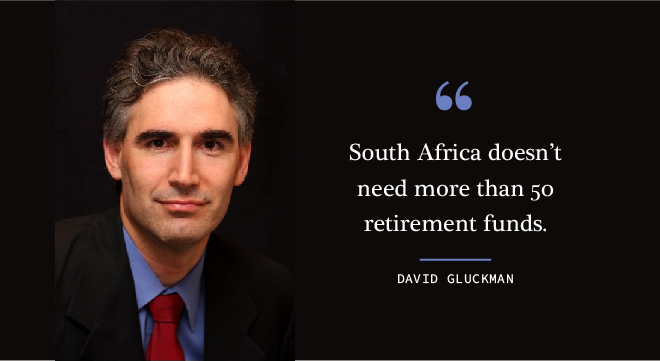David Gluckman, the chairperson of the Sanlam Umbrella Fund, the third-largest umbrella fund in South Africa, has backed calls by National Treasury and Finance Minister Enoch Godongwana for greater consolidation in the retirement-funding industry.
Gluckman, who is also the head of special projects at Sanlam Corporate, told the Sanlam Umbrella Fund Symposium last week that between 10 and 50 funds would be “the right number”.
He agreed with Treasury deputy director-general Ismail Momoniat’s comments on the green paper on social security reform. Momoniat said the country should have 20 or 50 or 100 retirement funds, not the 5 000 funds registered with the FSCA. Gluckman also noted that Godongwana this month spoke of having less than 50 funds, or even only 10 funds.
Gluckman said the “right type of debate” was how fast consolidation could take place to create a retirement industry with far fewer, bigger funds but with adequate competition.
His comments about consolidation were part of his response to criticisms of the financial services sector made by Alex van den Heever, adjunct professor and chair of Social Security Systems Administration and Management Studies at the Wits School of Governance, in article in the Daily Maverick on 24 August, “Comprehensive social security reform for South Africa is essential”.
Gluckman hit back at Van den Heever’s contention that the financial services sector suffered from high costs, inadequate competition and low consumer trust.
Costs
Gluckman said costs were an issue, but there was “clear evidence” that “real progress” has been made to reduce costs.
He pointed to Sanlam research showing that, in the commercial umbrella fund space, the average cost per member per year had decreased from slightly more than 2% in 2011 to about 1.66% per member per year in 2016.
He said all the investment portfolios offered by the Sanlam Umbrella Fund with a performance history of 10 years or more at 30 June were beating inflation (average of 5% over the period) by 4%, 5% or 6% a year, so even if 2% in costs was deducted, “members were earning good real returns that would enable them to have a decent retirement” if they kept on contributing over the long term.
Competition
Gluckman said the corporate pension and provident fund market in 2009 was marked by “too many weak competitors and too few strong competitors”. This had changed by 2016 and has continued to do so, so that today the market is completely different. “It is a highly competitive market … The pressure is on the providers to provide a good deal to members.”
He agreed with Van den Heever that the average South African was not in a position to choose one umbrella fund from another, but companies employ “highly capable” financial directors, managing directors, boards, etc who can make those decisions, which serve to protect the interests of all the members of the fund.
Trust
Gluckman said that anyone who believes that South Africa could have a central government-run fund that would keep accurate records, be corruption-free and provide good service without corruption was “living in dreamland”.
“I don’t think the public sector has the confidence of all South Africans to deliver in this regard.”
‘Basic income grant is necessary’
On the issue of a basic income grant (BIG), Gluckman said that, when one considered the impact of the unrest in July, his “intuition” was that South Africa could not afford not to have a BIG. The reality is that a large part of the population is not equipped to get work.
He said costing a BIG was far more complex than the quantum of the grant and who would qualify for it. A costing model also had to factor in what the recipients would do with the money and whether there would a multiplier effect that would benefit the economy.
South Africa could not afford to copy the welfare systems of other countries, nor was it good enough simply to say that “we need to solve the problem of unemployment”. South Africa needed a combination of reforms to reduce unemployment and affordable welfare measures, according to Gluckman.
The industry should not simply “bat away” proposals for social security reform; it needed to engage and show that what has been done over the past decade was working.



